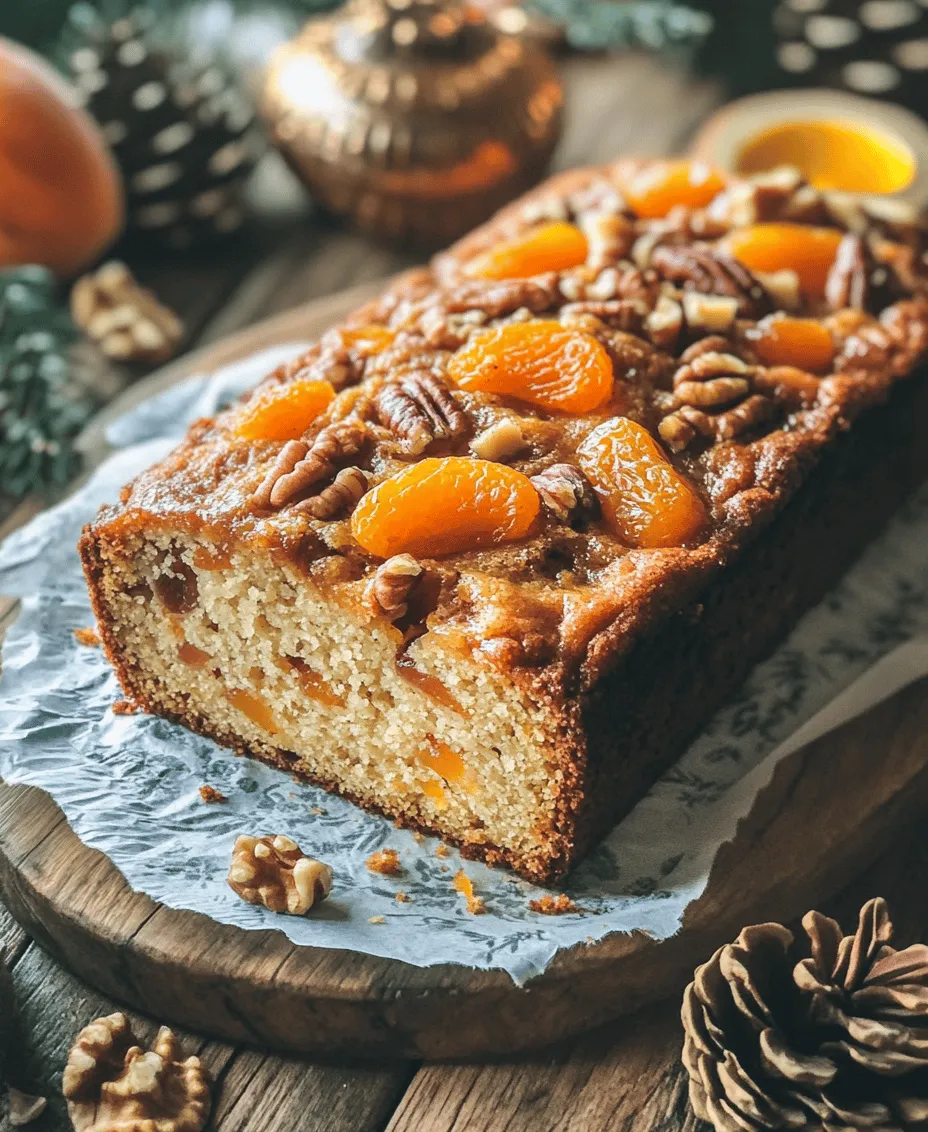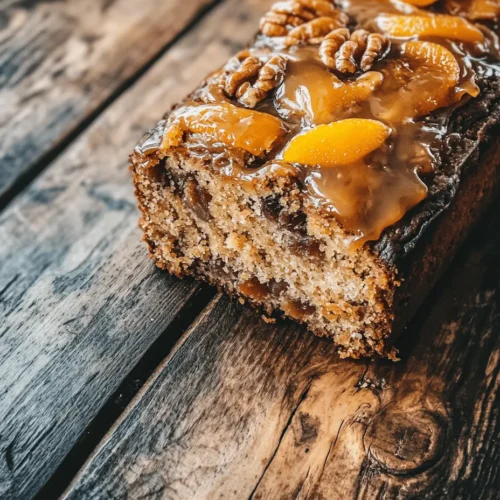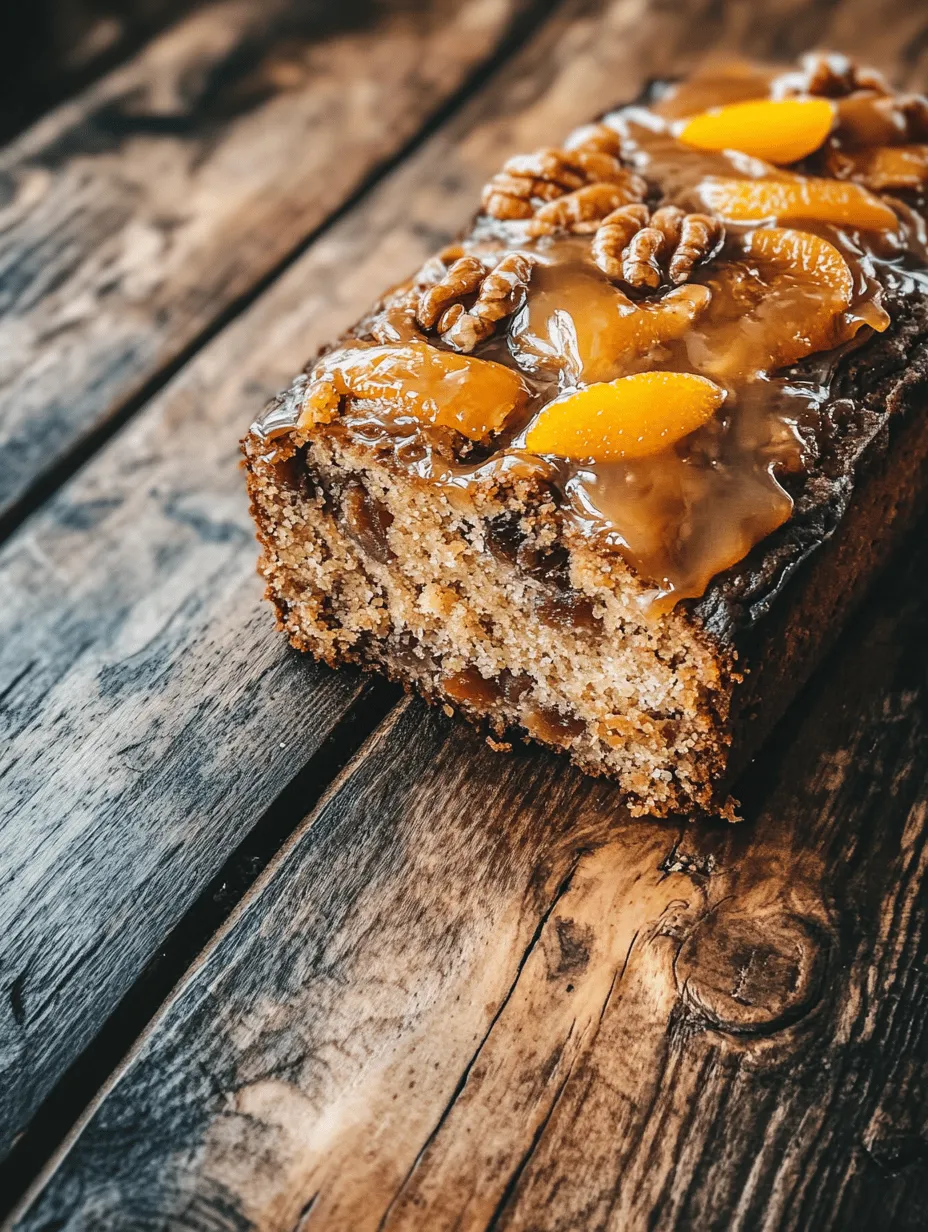Introduction
Fruitcake has long been a beloved staple in culinary traditions across the globe, often associated with the festive seasons and celebrations. Dating back to ancient Rome, fruitcake evolved over centuries, with various cultures putting their own twist on this rich, dense treat. The earliest versions contained a mix of honey, nuts, and dried fruits, making it not only a delicious dessert but also a source of sustenance. Today, fruitcake is often seen as a holiday classic, but it can also be enjoyed year-round as a delightful snack or dessert.
In this article, we introduce a “Quick & Easy Apricot and Walnut Fruitcake,” a simplified version of this traditional recipe that packs a punch in flavor while being straightforward to prepare. This fruitcake is perfect for those who appreciate the richness of dried fruits and nuts but are looking for a less complicated approach to baking. The combination of sweet apricots and crunchy walnuts provides a unique twist, making this cake a crowd-pleaser for any occasion.
Baking with dried fruits and nuts not only enhances the flavor profile of your dessert but also contributes to its nutritional value. Dried fruits are concentrated sources of essential vitamins, minerals, and dietary fiber, while nuts like walnuts are rich in healthy fats and protein. Together, they create a hearty cake that is both satisfying and nourishing.
Understanding the Ingredients
Dried Apricots: A Nutritional Powerhouse
Dried apricots are a key ingredient in our fruitcake, bringing a distinct sweetness and chewy texture. These small, golden delights are packed with nutrients. They are rich in vitamin A, which is essential for maintaining good vision, skin health, and immune function. Additionally, dried apricots are high in dietary fiber, aiding in digestion and promoting a feeling of fullness. Their natural sugars provide a quick energy boost, making them an ideal addition to baked goods.
When selecting dried apricots for this recipe, look for those that are unsweetened and have a vibrant color. This ensures that you are getting the best flavor and the most health benefits, without any unnecessary added sugars.
Walnuts: Flavor and Texture Enhancer
Walnuts play a pivotal role in enhancing the flavor and texture of our apricot and walnut fruitcake. Their rich, buttery taste complements the sweetness of the dried apricots beautifully. Beyond their delicious flavor, walnuts are also a nutritional powerhouse. They are high in omega-3 fatty acids, which are known for their heart-healthy benefits. Additionally, walnuts provide antioxidants, vitamins, and minerals that contribute to overall health.
When incorporated into the fruitcake, walnuts add a delightful crunch, creating a satisfying contrast to the chewy apricots. Ensure that you chop the walnuts into evenly sized pieces so they distribute well throughout the cake.
Mixed Dried Fruits: A Symphony of Flavors
In addition to dried apricots, this fruitcake can benefit from a variety of mixed dried fruits. These can include raisins, cranberries, or figs, each adding its own unique flavor and texture to the cake. The combination of different dried fruits not only enhances the taste but also adds visual appeal, making the cake more inviting.
When selecting mixed dried fruits, opt for a blend that complements the apricots and walnuts. This will create a harmonious balance of sweetness and tartness in every bite. The diversity of flavors will elevate the fruitcake from simple to extraordinary.
The Role of All-Purpose Flour
All-purpose flour is the backbone of our fruitcake, providing the necessary structure and stability. The proteins in flour help create gluten, which gives the cake its desired texture. For this recipe, using all-purpose flour ensures that the cake has a soft crumb while retaining enough density to hold the fruits and nuts.
When measuring flour, it’s important to do so correctly. Spoon the flour into a measuring cup and level it off with a straight edge. Avoid packing the flour into the cup, as this can result in a denser cake than intended.
The Importance of Butter, Sugar, Eggs, and Milk
To create a moist and flavorful fruitcake, we will use butter, sugar, eggs, and milk. Each of these ingredients plays a crucial role in the cake’s overall structure and taste:
– Butter: Adds richness and moisture to the cake, contributing to its tender crumb. Using unsalted butter allows for better control over the cake’s overall saltiness.
– Sugar: Not only sweetens the cake but also helps to create a desirable texture. It aids in the creaming process, which incorporates air into the batter, resulting in a light and fluffy cake.
– Eggs: Act as a binding agent, holding the ingredients together while also adding moisture. They also contribute to the cake’s rise and structure.
– Milk: Works to hydrate the dry ingredients and adds a touch of creaminess to the batter. It also helps to balance the sweetness of the fruits and sugar.
Flavor Enhancements: Orange Zest and Vanilla Extract
To elevate the flavors in our fruitcake, we will incorporate orange zest and vanilla extract. Orange zest adds a bright, citrusy note that complements the sweetness of the dried fruit, while vanilla extract provides a warm, aromatic essence that enhances the overall flavor profile. Both ingredients are crucial in creating a well-rounded and aromatic cake that is enjoyable to the palate.
Preparation Steps Explained
Before diving into the mixing and baking process, it is essential to prepare your workspace. Start by preheating your oven to 350°F (175°C). This step is crucial, as it ensures that the cake bakes evenly and rises properly. While the oven is heating, prepare your cake pan by greasing it with butter or lining it with parchment paper to prevent sticking.
Combining Dried Fruits and Nuts
A key to achieving an evenly distributed cake is to combine the dried fruits and nuts before incorporating them into the batter. Chop the dried apricots and walnuts into uniform pieces to ensure they mix well throughout the cake. Toss the chopped fruits and nuts together in a bowl, coating them lightly with a dusting of flour. This will help prevent them from sinking to the bottom of the cake during baking.
Mixing Dry and Wet Ingredients
With your dried fruits and nuts prepared, it’s time to mix the dry and wet ingredients. In a large mixing bowl, whisk together the all-purpose flour, baking powder, and a pinch of salt. These dry ingredients will create the base of your batter.
In a separate bowl, begin the process of creaming the butter and sugar. This step is essential for creating a light and airy cake. Use an electric mixer to beat the softened butter and sugar together until the mixture is light in color and fluffy in texture. This process typically takes about 3-5 minutes and incorporates air into the mixture, which is key for a tender cake.
Incorporating Eggs Properly
Next, add the eggs to the creamed butter and sugar one at a time. Beat well after each addition to ensure that the eggs are fully incorporated. This is important, as it helps to create an emulsion that contributes to the cake’s structure and moisture.
Alternating Dry and Wet Ingredients
Finally, it’s time to combine the dry and wet ingredients. Begin by adding one-third of the flour mixture to the butter and egg mixture, followed by half of the milk. Mix until just combined, then repeat the process, alternating between the dry ingredients and wet ingredients. This technique helps maintain the cake’s texture, ensuring it remains light and fluffy without overmixing.
Once all the ingredients are well combined, gently fold in the prepared dried fruits and nuts. Be careful not to overmix; you want the fruits and nuts to be evenly distributed without breaking them down.
With your batter ready, you are just steps away from baking a delicious apricot and walnut fruitcake that embodies the rich history and flavors of this beloved dessert. Get ready to enjoy a slice of this delightful treat that is both simple to make and full of flavor!

Importance of Gently Folding in Fruit and Nut Mixture
When it comes to baking, the method of incorporating ingredients can significantly impact the final product. For our Quick & Easy Apricot and Walnut Fruitcake, gently folding in the fruit and nut mixture is crucial. This technique helps to avoid overmixing, which can lead to a dense and tough cake. By carefully folding the mixture, you maintain the lightness of the batter and ensure that the fruits and nuts are evenly distributed throughout the cake. Using a spatula, slide it down the side of the bowl and lift the batter from the bottom to the top, turning the bowl as you go. This process should be done slowly and deliberately to preserve the air bubbles created during mixing.
The Baking Process
Optimal Baking Temperatures and Times for Fruitcake
Baking the Quick & Easy Apricot and Walnut Fruitcake requires an optimal temperature to ensure even cooking. Preheat your oven to 325°F (160°C). This moderate temperature allows the cake to bake thoroughly without burning the edges. The baking time will typically range from 50 to 60 minutes, depending on your oven’s calibration and the specific baking dish used. A loaf pan will generally cook faster than a round cake pan, so keep an eye on your cake as it approaches the 50-minute mark.
Tips on Checking for Doneness Using the Toothpick Method
To ascertain that your fruitcake is perfectly baked, employ the classic toothpick method. Insert a toothpick or skewer into the center of the cake; if it comes out clean or with a few moist crumbs attached, your cake is done. If the toothpick emerges with wet batter, it requires additional baking time. Remember to avoid opening the oven door too frequently during the baking process, as this can disrupt the baking temperature and lead to uneven results.
Importance of Cooling the Cake Properly
Once your fruitcake is baked to perfection, cooling it properly is vital for achieving the right texture and flavor. Remove the cake from the oven and allow it to cool in the pan for about 10-15 minutes. This resting time helps the cake firm up and makes it easier to remove from the pan without breaking. Afterward, transfer it to a wire rack to cool completely. Cooling allows the flavors to meld and develop, resulting in a more delicious cake. Avoid cutting into the cake while it is still warm, as this can lead to a crumbly texture and a loss of moisture.
Serving Suggestions
Presentation Ideas for the Fruitcake
Presentation is key when serving your Quick & Easy Apricot and Walnut Fruitcake. Consider placing your cooled cake on a decorative cake stand to elevate its appearance. You can slice the cake into thick wedges for a rustic look or into smaller pieces for more formal gatherings. A simple garnish can go a long way; lightly dust the top with powdered sugar for a snowy effect, or add fresh apricots and walnuts on the side for a colorful contrast.
Pairing Options
This fruitcake pairs wonderfully with a variety of beverages, making it a versatile addition to any gathering. Serve it alongside a cup of hot tea or coffee for a delightful afternoon treat. The sweetness of the cake complements the bitterness of coffee beautifully, while the fruity notes harmonize with a floral tea. Alternatively, you can present the fruitcake as a dessert centerpiece at a dinner party, accompanied by a scoop of vanilla ice cream or a dollop of whipped cream.
Suggestions for Garnishing
To elevate your serving experience, consider garnishing your fruitcake with fresh fruits, such as sliced peaches or berries. This adds a pop of color and freshness to the dish. Additionally, a drizzle of honey or a light glaze can enhance the overall flavor profile. For a festive touch, you may also want to add candied citrus peel or edible flowers, which make the presentation even more inviting.
Storage and Shelf Life
Tips for Storing the Fruitcake
To maintain the freshness of your Quick & Easy Apricot and Walnut Fruitcake, proper storage is essential. Once completely cooled, wrap the cake tightly in plastic wrap or aluminum foil to prevent moisture loss. Place the wrapped cake in an airtight container or zip-top bag to further protect it from air exposure. Store it in a cool, dry place, away from direct sunlight.
Discussion of How the Flavors Develop Over Time
One of the delightful aspects of fruitcake is that its flavors improve with time. Allowing the cake to rest for a day or two before serving enables the ingredients to meld, resulting in a more flavorful experience. This resting period enhances the sweetness of the dried fruits and the nuttiness of the walnuts, creating a harmonious balance of tastes.
Best Practices for Freezing and Thawing Fruitcake
If you wish to extend the shelf life of your fruitcake, freezing is an excellent option. To freeze, wrap the cooled cake tightly in several layers of plastic wrap and then in aluminum foil. Label the package with the date to keep track of its storage time. When you’re ready to enjoy your fruitcake, transfer it to the refrigerator to thaw overnight. After thawing, allow the cake to come to room temperature before serving to ensure the best flavor and texture.
Nutritional Information
Breakdown of Nutritional Aspects Per Serving
Understanding the nutritional profile of your Quick & Easy Apricot and Walnut Fruitcake can help you enjoy it guilt-free. Each serving (approximately 1 slice or 1/12 of the cake) contains:
– Calories: 180
– Total Fat: 8g
– Saturated Fat: 1g
– Cholesterol: 30mg
– Sodium: 50mg
– Total Carbohydrates: 25g
– Dietary Fiber: 2g
– Sugars: 10g
– Protein: 3g
This breakdown shows that the fruitcake is a manageable indulgence, especially when enjoyed in moderation.
Health Benefits of the Ingredients Used in the Recipe
The ingredients in your fruitcake offer various health benefits. Walnuts are a fantastic source of omega-3 fatty acids, which are beneficial for heart health. Apricots provide essential vitamins and minerals, including vitamin A and potassium, which support overall wellness. Additionally, the dried fruits used in the cake are rich in antioxidants, which can help combat oxidative stress in the body. Overall, this fruitcake is not just a treat but also a source of wholesome ingredients that can contribute positively to your diet.
Conclusion
In summary, the Quick & Easy Apricot and Walnut Fruitcake is a delightful dessert that is both simple to make and versatile for any occasion. Its unique blend of flavors and textures makes it an ideal choice for casual gatherings, holiday celebrations, or as a thoughtful homemade gift. With its ease of preparation, this recipe allows you to enjoy a delicious fruitcake without the fuss often associated with traditional baking.
We encourage you to try this recipe for your next event, and as you do, consider exploring more baking recipes that incorporate dried fruits and nuts. These wholesome ingredients can add a delightful twist to traditional desserts while providing nutritional benefits. Happy baking!



